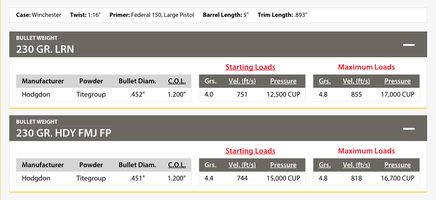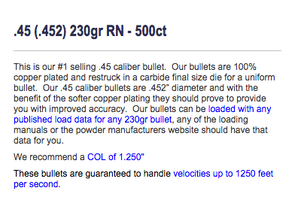HarryPottar
NES Member
Does this crimp make my gun look dirty to you?
Caliber: 45acp
Brass Cleaning: Dry
Bullet: Berry’s RN Copper Plated 230gr .452
Brass: Mixed
Primer: CCI 300, Large Pistol Primer
COL: 1.250
Powder: Tight Group 4.5 grains.
Purpose: Plinking very evil paper targets
Retail Base Line: Wally World Winchester white box 200 round 230gr range pack.
Once again thanks for everyones help in my reloading journey.
I purchased my first 1911 a Smith & Wesson E series, very pleased with it so far.
I started reloading 45 acp on the Dillion 650XL, I did my ladder set and compared the retail base line with the chronograph and the 4.5grains was with in 50fps.
However, I noticed that the gun is a lot dirtier when using the reloads over retail, also the reloads shoot a little lower and to the left.
I did some googling and there is lots of talk about dirty powder, slow/fast burn and the winchester 231 is cleaner that tight group.
I know that components are subjective, but the other thing that came up was the crimp. I saw mentioned in a couple of places that a tight crimp can cause dirty gun.
The bottom of the brass where the powder is, measures 0.4730 and where the crimp is measures 0.4700. It does not look tight but I don’t have the experience yet ti visually judge.
Should I ease off on the crimp, should I increase the powder to get the extra 50fps, should I change powder or just buy share in CLP
Thanks in advance
Harry
Caliber: 45acp
Brass Cleaning: Dry
Bullet: Berry’s RN Copper Plated 230gr .452
Brass: Mixed
Primer: CCI 300, Large Pistol Primer
COL: 1.250
Powder: Tight Group 4.5 grains.
Purpose: Plinking very evil paper targets
Retail Base Line: Wally World Winchester white box 200 round 230gr range pack.
Once again thanks for everyones help in my reloading journey.
I purchased my first 1911 a Smith & Wesson E series, very pleased with it so far.
I started reloading 45 acp on the Dillion 650XL, I did my ladder set and compared the retail base line with the chronograph and the 4.5grains was with in 50fps.
However, I noticed that the gun is a lot dirtier when using the reloads over retail, also the reloads shoot a little lower and to the left.
I did some googling and there is lots of talk about dirty powder, slow/fast burn and the winchester 231 is cleaner that tight group.
I know that components are subjective, but the other thing that came up was the crimp. I saw mentioned in a couple of places that a tight crimp can cause dirty gun.
The bottom of the brass where the powder is, measures 0.4730 and where the crimp is measures 0.4700. It does not look tight but I don’t have the experience yet ti visually judge.
Should I ease off on the crimp, should I increase the powder to get the extra 50fps, should I change powder or just buy share in CLP
Thanks in advance
Harry


